When growing high yielding varieties, often other agronomic features such as disease resistance are sometimes overlooked. The fungicides at our disposal today are capable of producing extremely good results, but it is important to apply as much thought to the fungicide programme and timings as to the choice of product, to achieve optimum yield potential.
Over recent years, the emphasis has moved away from reactive fungicide applications to treat visible disease in the crop and more towards a strategy where prevention is better than cure. To achieve this, the fungicides must be applied at the correct time and early in the development of the disease in field crops, or even before infection occurs, with timing influenced by growth stage, weather and the variety’s disease resistance.
Disease resistance
The AHDB Recommended Lists expresses disease ratings on a scale of 1 to 9, with 1 being poor resistance to the disease and 9 being good. Any variety with a resistance rating for a particular pathogen of 7 or below would require careful attention and a strategic approach to disease control.
Out of all the winter wheat varieties on the 2023/24 AHDB Recommended List, only six varieties have a Septoria tritici rating higher than 7. Therefore, in the wetter West almost every variety must be considered as at risk from Septoria infection and all require a robust fungicide programme.
Read more: Your guide to Septoria tritici blotch (STB)
For those varieties with a Septoria rating of mid-6 and above, a robust fungicide strategy is still required, but the timings of the applications can be a little more flexible.
When modern SDHI chemistry is employed for Septoria control, along with an active such as folpet with multi-site activity, and supported by an appropriate dose of triazole, we can achieve very acceptable levels of control of other important diseases. However, the 2023/24 recommended list contains a number of varieties with a low resistance to mildew and for those with a rating of 6 or below, an additional specific mildewicide will probably be required.
How to choose the right herbicide programme
With all aspects of agronomy, there is rarely a ‘one size fits all’ solution and flexibility in approach is essential. When planning herbicide programmes there are two key timings to be considered; pre-emergence and post-emergence of the crop and weeds.
The most effective herbicide programmes usually commence with a planned pre-em application of residual herbicide. Depending on the situation and the weed spectrum, if an effective pre-em herbicide is applied, additional weed control later in the season may not be required, therefore saving both time and money.
It is important to work with your agronomist or specialist to develop a herbicide strategy that takes into account soil type, drilling date and the expected weed spectrum.
"It is important to work with your agronomist or specialist to develop a herbicide strategy that takes into account soil type, drilling date and the expected weed spectrum"
What are the application options?
In winter cereals, one pass with a pre-em containing actives such as flufenacet, diflufenican or pendimethalin will often do a very good job in controlling a broad spectrum of broad-leaved weeds and annual meadow grass, with a second pass sometimes needed to control spring germinating species.
For more problematic weeds and diseases such as blackgrass or brome, there should be a pre-planned herbicide strategy in place which adopts the principle of ‘stacking’ several different active ingredients, each with a different mode of action. In addition to ‘stacking’ chemistry, a split-timed approach with pre-em and peri-em applications will help to extend the period of residual herbicide activity into the autumn.
For help with planning a cost-effective herbicide strategy, and advice on the best fungicides for the varieties you’re growing, contact your local Wynnstay Agronomist or Arable Specialist to discuss options and timings.












